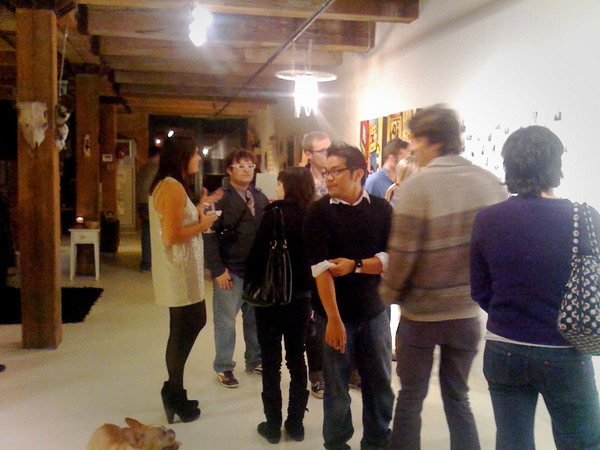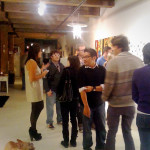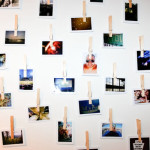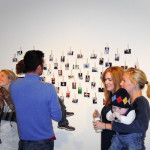Glovebox is a grassroots nonprofit artist-run organization committed to creating a community for emerging artists and supporting a platform that enables them to exhibit art in nontraditional spaces in the greater Boston area. This fall, Glovebox continues its mission and we are here to talk with co-founder Jodie Baehre about the latest alternative art exhibition: Cellphone Photo Soiree.
Julie Novakoff: First, can you tell me about Glovebox and how it got started?
Jodie Baehre: When I graduated from the Art Institute of Boston it became very clear to me that most galleries did not support emerging artists. I had to think of a way to continue exhibiting my work outside the traditional spaces. My former classmate Liz Comperchio and I decided to form Glovebox, a non-profit dedicated to establishing more recognition for undiscovered artists in the Boston area. We represent all media including fine art, photography, film, sculpture and music. Our aim is to gain a larger voice as a group, yet still be seen as individual artists. Create. Be a part of a community. And make it your own.
JN: So Cellphone Photo Soiree is one of many exhibitions Glovebox has sponsored. Can you talk briefly about the particular concerns that have shaped this show?
JB: With the emergence of digital technology the process of making photographic images has never been so readily available. Production has become fast and effortless. Photos can be taken by the hundreds -- easily downloaded, sorted, and disseminated. All this with a few clicks of the mouse! In our digital age, it seems that everyone has become an instant "artist", but what does this mean for professional image-makers? I'm also interested in addressing how digital technologies alter our relationship to live experiences.
In an attempt to address these concerns, I asked Glovebox artists, fellow neighbors and artists of the Midway Studios, family, friends, and co-workers to submit photos. I thought, "Why not use technology to receive images but then take the image back to its traditional form, a photographic print?"
I was intentionally vague and did not specify any particular theme. What you see are 132 images all labeled with the title, make of cell phone and name of the artist. I printed four of each print to encourage people to buy a work of art for the affordable price of $1!
JN: It's nice to have a memory of the exhibition itself and of course, for an affordable price. So let's talk about some of the images in particular. Some steer toward a realistic canon or a documentary style and others negate perspective entirely, intentionally using lighting, saturation and view to create an abstract field of color, form or conceptual-based image.
JB: This would be a sign that there are many themes within contemporary art, a pluralistic practice itself. Some images are taken with the intent to document a real moment, a live experience if you may. Tod Craggio chose to submit a photograph of a tattoo artist working and Lindsay Wright chose to submit a photograph of a rainbow stretched atop a cityscape-
Seth Hauben even felt the need whip out his camera to take a picture of his bowel movement in the toilet and another one of his photos is of a Heinz ketchup label that reads, "I PUT KETCHUP ON MY KETCHUP"- not your average bottle of sauce! Janelle Roscoe explores form and composition with her photograph of a chandelier that actually looks more like an array of orange balloons floating in a sea of blackness, an effect that she achieved through dim lighting.
JN: Cellphone Photo Soiree clearly challenges traditional ideas about the beauty, quality, skill, and form of art. It also challenges us to view art in an alternative space, outside the confines of a museum or gallery. Can you explain your curatorial decision to install cloth pins on the wall to secure the photographs?
JB: Photographic prints were traditionally viewed within a home, a physical space where loved ones and friends gathered. I wanted to try and re-create this space- where ideally one feels comfortable to engage in dialogue. After all, I promised to print and hang their digital images in hand-held form, with other people, in the flesh! How about that! REAL LIVE HUMAN CONTACT!
JN: To your point about human contact, you will be happy to hear that Kate Castelli and Zak Kubert, two local artists who frequently contribute to Glovebox exhibitions, claimed that these events "keep them sane".
Just tonight, being here in this space, I have engaged in a debate about graffiti art, provoked by Ari Haben's photograph of a Boston wall tagged with the statement "Will Not Draw As I Am Told" and have also heard three local musicians burst out in improvisational rhythm. There is no doubt that the vitality of a shared experience was made possible in this alternative space.
JN: Any idea about what's next for Glovebox?
JB: I definitely want to dive deeper into Boston's public art scene to find alterative spaces to collaborate with musicians, graffiti artists and other grassroots arts organizations. Liz Comperchio has moved to New York and will now expand the Glovebox reach. She is currently organizing "art attacks"- art that spontaneously and collaboratively is produced by artists and placed around the city.
"Cellphone Photo Soiree " was on view Monday, October 12 from 7-9 pm at Midway Studios in Fort Point, Boston, MA
All images are courtesy of the author.







